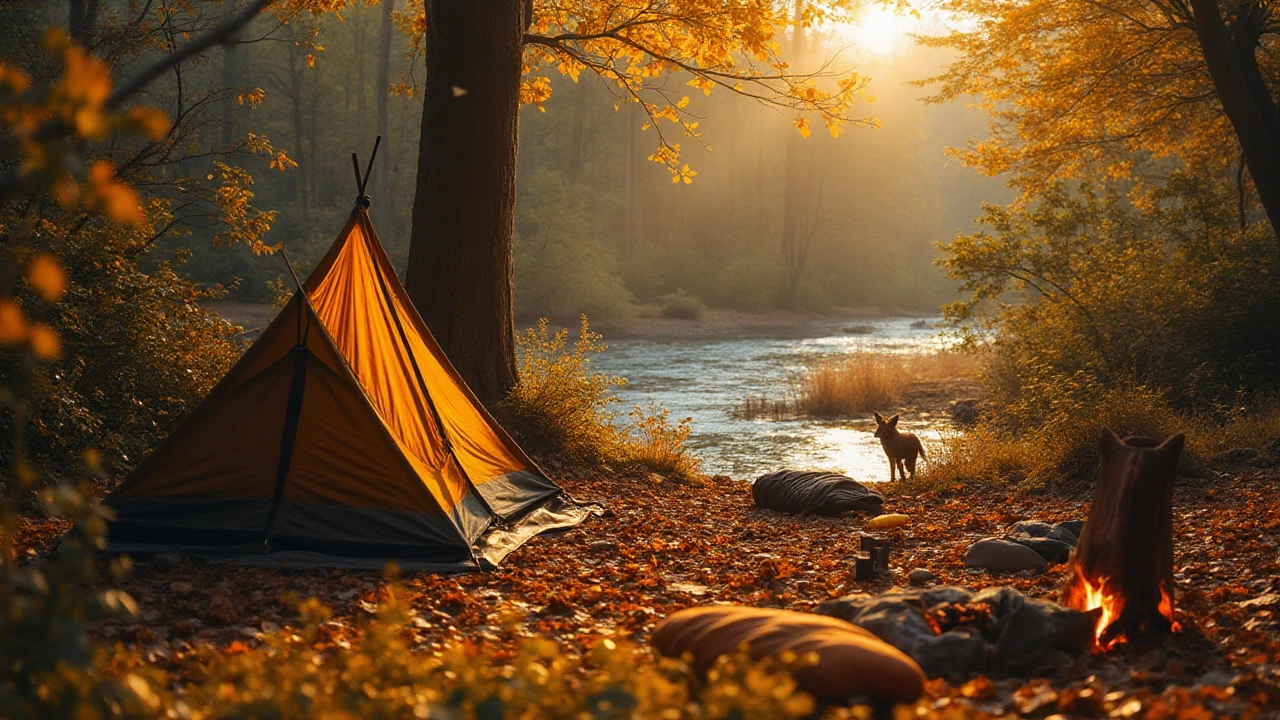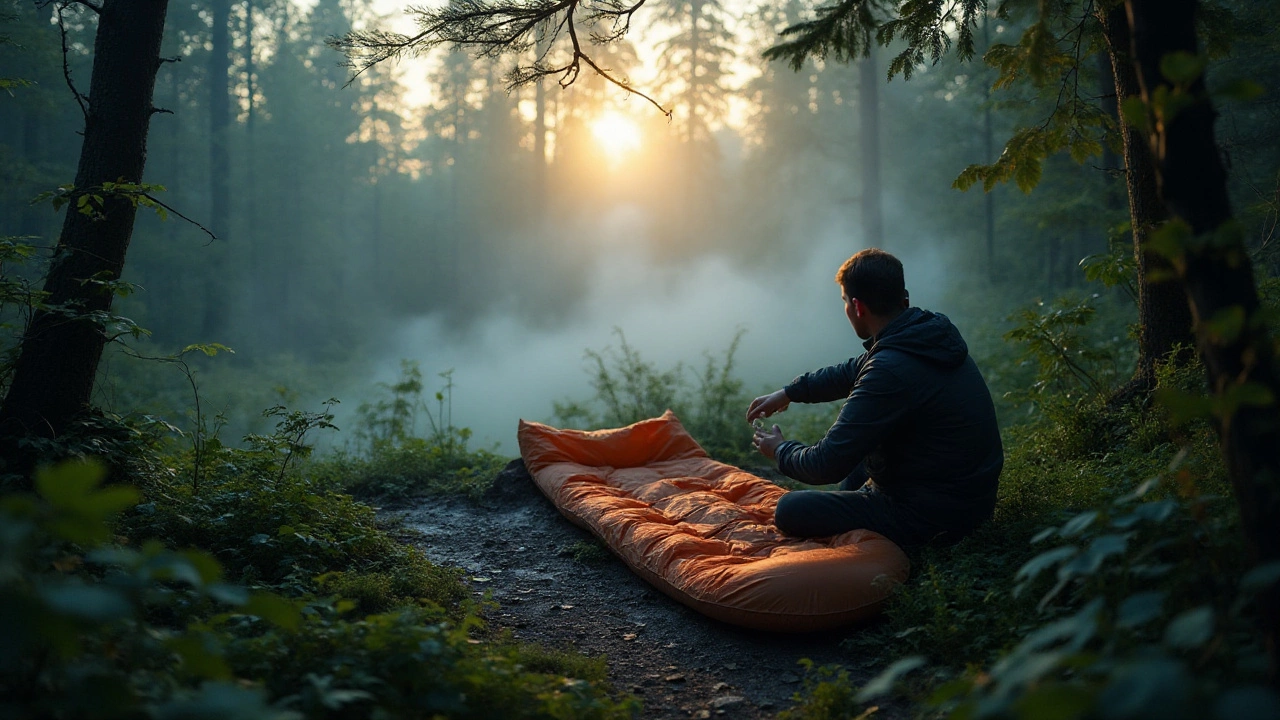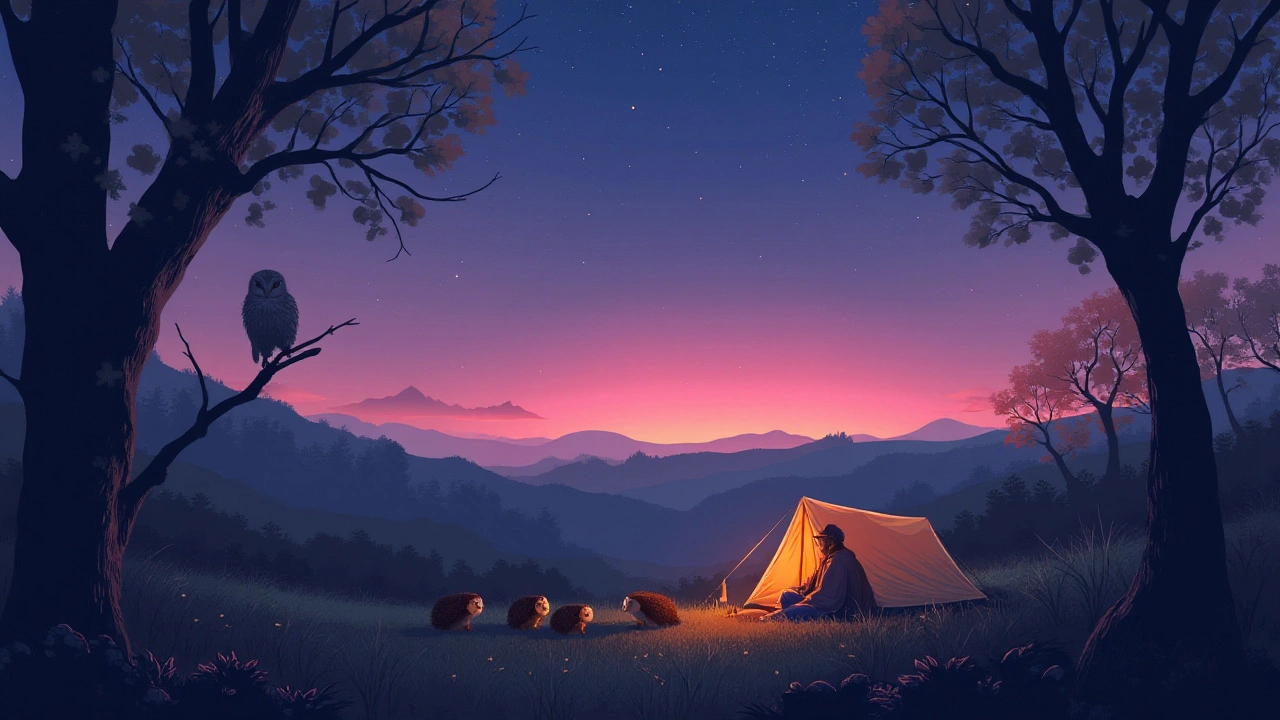Is Sleeping in the Forest Without a Tent Safe? Tips and Considerations
 Jan, 6 2025
Jan, 6 2025
Imagine dropping your gear and unfurling your sleeping bag under a blanket of stars, serenaded by the rustle of leaves and the distant hoot of an owl. Sleeping in the forest without a tent certainly has its appeal, allowing you to connect more intimately with nature. But the question remains—how safe is it really?
There are several factors, like weather conditions and local wildlife, one must consider before opting to journey without a tent. The absence of a tent can mean exposure to the elements and curious critters, making preparation crucial. This article dives into the nuances of tentless camping, offering tips and insights for those who crave a raw nature experience without compromising their safety.
- The Appeal of Sleeping Without a Tent
- Weather and Environmental Factors
- Wildlife Encounters and Safety Precautions
- Essential Gear for a Tentless Night
- Tips for a Comfortable and Safe Experience
The Appeal of Sleeping Without a Tent
For many, camping is a journey into the wild where the essence of adventure is distilled to its purest form. The sky becomes your ceiling, the forest your walls, and the ground your bed. There's an undeniable raw beauty in sleeping in forest camping sites without the artificial barrier of a tent. The experience of being cradled by the natural world can be both exhilarating and profoundly peaceful. It offers an unfiltered connection with nature that even the thinnest of tent fabrics can buffer. Breathing in the crisp night air, gazing up at the infinite stars, and listening to the symphony of nocturnal creatures can feel liberating and enhance one’s appreciation of our environment.
Many nature enthusiasts seek tentless camping for the simplicity it provides. Without the need to pitch a tent, your pack becomes lighter, and setup time is drastically reduced. This allows more freedom to explore deeper into the woods or to stay nimble and move locations quickly if adventure calls. Moreover, ditching the tent often means fewer boundaries between you and the intricacies of the moment—feeling the misty chill of dawn or watching the forest awaken as sunlight seeps through the canopy. Sleeping directly under the stars can feel like indulging in a storyline woven by Mother Nature herself, offering a sense of timelessness and continuity.
"Sleeping under the stars on a clear night reminds us how vast the universe is and how small our worries are in comparison," says renowned wilderness expert John Muir.
Choosing to forego a tent isn't just a romantic notion; it can also be practical when camping in temperate climates or during the warmer months. Without the need for a tent, you have fewer items to manage and less to carry, making your expedition about exploration rather than logistics. This form of minimalist camping echoes back to ancient times when humans routinely slept amidst nature. Plus, the absence of a tent provides an unfiltered experience of nature's nightly wonders—watching a deer tiptoe past, the sight of fireflies dancing in the dark, or even spotting the swift dart of a shooting star becomes more attainable.
However, the appeal isn't solely ecological or logistical. Many adventurers find that going without a tent instills a deeper sense of resilience and adaptability. Embracing this rugged style of camping may initially pose challenges, such as adapting to new noises or moderating temperature changes, but it also fosters a sharp sense of awareness and readiness. This heightened alertness becomes part of the thrill, creating stories to share and memories to treasure long after returning to the daily grind.
While the allure of sleeping without a tent is strong, it invites a balance between embracing nature and ensuring one’s camping safety. Every rustle and whisper of the forest becomes vivid, drawing the camper into a closer embrace with the wild environment around them. This intimate connection has healing qualities, soothing the mind and invigorating the soul, reminding us, even if just for a night, why our ancestors lived as part of the natural landscape so harmoniously.
Weather and Environmental Factors
Embarking on an adventurous forest excursion without the comfort of a tent requires more than sheer courage. The first element to brace yourself against is the unpredictable nature of weather. Many enthusiasts often overlook precisely how much the weather can affect their experience when ditching the tent. A serene evening can quickly turn challenging if a sudden downpour catches you off guard, leaving you drenched and shivering. That's why understanding the local climate and predicting weather conditions is essential. Checking reliable sources such as meteorological websites or apps before your trip is a prudent first step to ensuring a safe and enjoyable adventure. Weather-wise, even if forecasts predict clear skies, it doesn't hurt to at least carry a portable tarp or rainfly for just-in-case situations.
"In wilderness, there are no bad weather conditions, only inappropriate gear." - mountaineering adage.
The environmental setting of the forest also plays a significant role in defining the safety of camping outdoors sans a tent. Dense forests with thick canopies can regulate daytime temperatures, keeping areas cooler, whereas open spaces may offer little to no reprieve from heat. The terrain also can pose challenges—moist ground can make sleeping uncomfortable, and rocky or uneven surfaces might cause strain or injury during sleep. Towards this end, a good sleeping pad can ensure insulation from damp ground and provide comfort on uneven land. Understanding the forest’s ecosystem helps tailor what gear you'll need or choose an optimal resting spot which can influence the quality of your rest.
While tentless camping, an adventurer's mantra should ideally include safeguarding themselves against bugs and critters prowling in outdoor settings. Bug nets can become your best friend during warmer seasons, protecting against mosquitoes and other insects. Additionally, choosing to camp on higher ground can potentially mitigate encounters with larger animals who might frequent lower, forested areas for food and water. Depending on your chosen camping region, the danger from wildlife might vary, so taking time to understand local fauna is invaluable, helping ensure you're prepared for more significant encounters. Keeping food stored securely away from your sleeping site can also deter curious critters from dropping by during the night.
Lastly, one cannot overlook the profound impact that camping in this minimalist manner can have on the forest environment itself. Responsible camping includes respecting the habitat, ensuring what you bring in, you take out. This includes managing waste effectively and avoiding the disruption of local flora and fauna. The philosophy of 'leave no trace' should underpin each camper's actions, so the beauty of the forest can sustain itself and be shared by future nature enthusiasts. Opting for biodegradable products, minimizing campfire impact, and being mindful of wildlife interaction are fundamental practices for environmentally conscious explorers.

Wildlife Encounters and Safety Precautions
Sleeping under the open sky in forested areas is sure to bring you close, sometimes uncomfortably close, to the local wildlife. Forests are teeming with creatures that have carved out their own niches, and understanding their habits can significantly enhance your safety and enjoyment of a forest camping adventure. One of the primary concerns often cited by those considering tentless camping is the risk of unwelcome nocturnal visits from wild animals.Sensible precautions—like storing food in airtight containers and keeping your campsite clean—can drastically reduce these risks. Animals are primarily attracted to the scents of food, which is why strategic food storage is essential. A basic rule is to keep your food at least 200 feet away from your sleeping area to avoid inviting critters into your personal space.
Different forests host different animals, and knowing what to expect can help you plan accordingly. In North American forests, you're likely sharing the space with raccoons, bears, deer, and a range of birdlife. Raccoons, known for their cleverness, are particularly infamous for nightly snack theft if care is not taken. And with larger animals like bears, knowledge and preparedness are key. Put your food and scented items into a bear-proof container or hang them from a tree using a rope to prevent bears from accessing them.
When it comes to bears, bear spray can become your ally. Even though encounters are rare, it's wise to carry it with you as a precaution. Scan your surroundings for any signs of animal activity, such as scat or tracks. This awareness enables you to spot potential risks before setting up camp. Practice making noise as you move, which can act as an auditory beacon, signaling the wildlife of your presence and giving them plenty of time to avoid you.
Respect the Wildlife Habitat
Respecting the land means understanding that you are a guest in these animals' homes. An integral part of camping safety involves respecting wildlife from a distance and observing their behaviors without interference. Ensure you do not disturb their natural activities. It's worth noting that quite a few animals are more threatened by humans than we are by them. According to the National Park Service, more people are killed by bees, wasps, mosquitos, and snakes than by bears or mountain lions every year.
"The place of nature is where we go to find ourselves, and we have a responsibility to protect these spaces and the creatures within them." — Anonymous
Understanding these dynamics could make a significant difference during your tentless night. Ultimately, the goal is not to provoke fear but to ensure you increase your awareness and respect for the wildlife around you while sleeping outdoors. Observing these creatures from a respectful distance can be a deeply rewarding part of the experience, offering insights into their behaviors and the intricate balance of their ecosystems.
Essential Gear for a Tentless Night
Camping without a tent requires a precise balance of freedom and preparation. The art of sleeping directly under the stars calls for specific gear that keeps you safe, comfortable, and ready for the unpredictable embrace of nature. One crucial item in your pack should be a high-quality sleeping bag. Opt for one with insulation suitable to the climate, which means checking temperature ratings. The material can mean the difference between a night of shivering and a restful sleep. Sleeping bag liners are an excellent addition, offering extra warmth on chillier nights.
Beyond the sleeping bag, invest in a durable sleeping pad. The forest floor can be unforgivingly hard and uneven, and a sleeping pad provides cushioning and insulation against the cold ground. While compact air pads are popular, some campers prefer closed-cell foam pads for their reliability and easy packing. A well-chosen sleeping pad not only preserves heat but also protects from occasional dampness.
Another essential is proper layering. When the sun dips below the horizon, temperatures can plummet quickly, even in the warmest climates. Layering clothing helps regulate body temperature. Start with moisture-wicking base layers to keep sweat from chilling you, followed by an insulating layer, and finally, a weather-resistant outer layer.
Incorporate a compact tarp or bivvy bag as your shelter option. They are lightweight alternatives to tents, designed to shield you from rain or dew without constraining your connection to the surrounding environment. A tarp can be strung between trees to create a canopy, while a bivvy bag offers a more intimate cocoon of protection. This minimal gear setup is perfect for those seeking to embrace a minimalist camping approach.
In terms of essentials, a reliable flashlight or headlamp is invaluable. The dark forest can be disorienting, and organizing your gear or responding to unexpected calls of nature requires proper illumination. Consider a model with various brightness settings and a red light option to maintain night vision. Additionally, always pack a first-aid kit. It should include basic supplies like adhesive bandages, antiseptic wipes, and pain relief medication.
Civilian adventurer Bear Grylls once noted, "Preparation is not just about having equipment, but also about planning effectively." While it's tempting to travel light, a filter or purification tablets for treating water you find in streams or lakes should not be neglected. Nature doesn't come equipped with taps, and being able to safely hydrate can be crucial to your camping success.
Optional Gear
Consider bringing a compact backpacking stove if you anticipate the need for hot meals or beverages. Dehydrated meals are lightweight and easy, needing only hot water to become nourishing. Lastly, carry a bag designed for collecting and disposing of any trash you create. One of the ethical guidelines of camping is to leave no trace of your stay behind, and respecting this helps maintain the wonder and purity of the camping spots for generations of adventurers to come.
Tips for a Comfortable and Safe Experience
Sleeping in the wild without a tent demands not only courage but also a solid plan. Ensuring a comfortable and safe night starts long before you unroll your sleeping bag. One of the first steps is choosing the right spot. It's ideal to find a flat area away from potential dangers like falling branches, and steer clear of animal trails, as these can lead to unwelcome nocturnal visitors. The groundwork for a peaceful night under the stars lies in the art and science of preparation. As temperatures can drop during the night, consider packing layers and a quality sleeping bag suitable for the anticipated nighttime temperature of the region.
Focus on weather conditions as they can significantly affect your outdoor sleeping experience. Checking the forecast can save you from an unexpected storm, allowing you to plan your shelter and gear accordingly. Consider bringing a tarp or bivvy sack to offer some protection against rain, dew, or insects. Being equipped with knowledge and the right tools not only enhances comfort but also contributes to your safety. Remember, the forest is teeming with curious creatures, so take steps to store food securely away from your sleeping area, preferably hung in a tree at a distance. Food scents can attract wildlife, and being cautious about storage can prevent such encounters.
Lighting plays a pivotal role during your tentless night in the forest. A reliable headlamp or flashlight is a must, providing visibility in the dark wilderness and ensuring that you can navigate safely after sunset. Setting up a small perimeter of light around your sleeping area not only deters wandering animals but also offers peace of mind. Respect the forest nightlife; keep your light dim and avoid illuminating the surroundings more than necessary. These steps do not only improve safety but also preserve the nocturnal charm of your campsite.
An often-overlooked tip is paying attention to the position and orientation of your sleep setup. Align your sleeping bag so that your head points up the slope if on a gradient, providing comfort and supporting proper blood circulation. Protecting yourself from insects merely requires packing an effective repellent and considering a lightweight mosquito net if bugs are a concern. Herbal repellents and essential oils can be a natural alternative for those sensitive to chemical sprays.
Do not underestimate the importance of understanding local wildlife and respecting their habitats. Camping safety is not just about avoiding danger; it involves being a considerate visitor. Learn about specific species you may encounter and any necessary precautions to take. By minimizing your impact on the environment and maintaining a safe distance from animals, not only are you looking after yourself, but you're also ensuring the forest remains a sanctuary of peace for its inhabitants. "A good traveler leaves no tracks," Lao Tzu once noted, a sentiment only achieved through careful planning and a deep appreciation for nature.